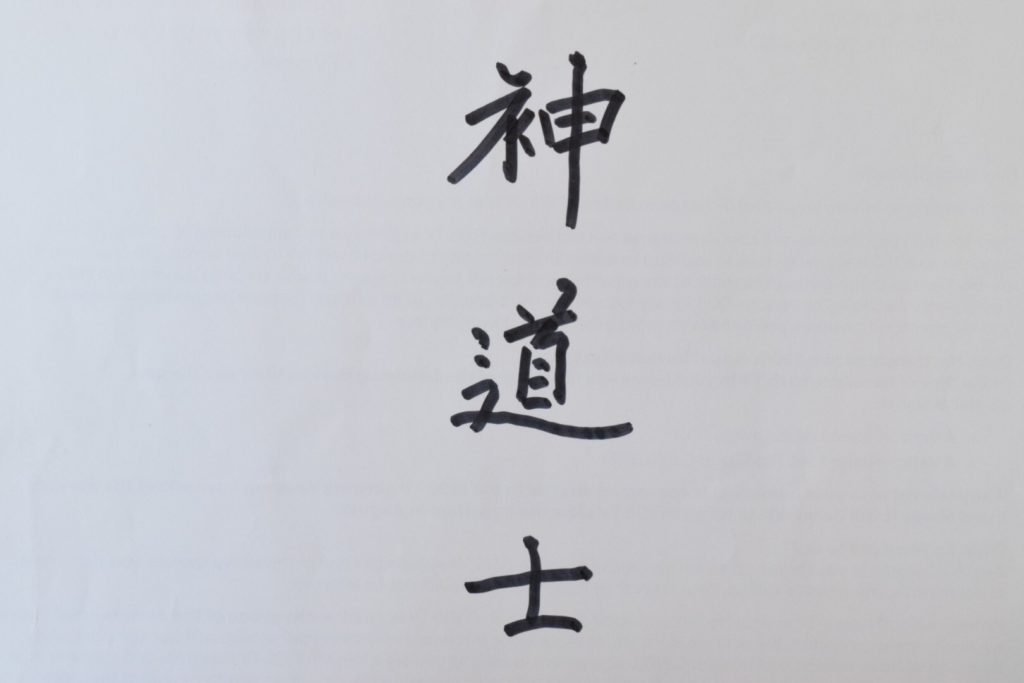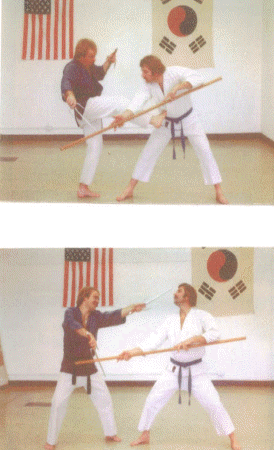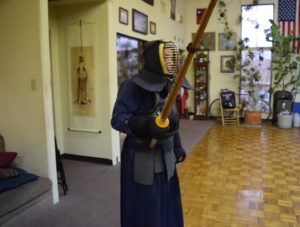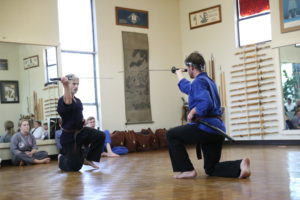History of Shin-Toshi
 America’s oldest system, and best kept martial arts secret!
America’s oldest system, and best kept martial arts secret!
The System
During the mid-sixties, Mickey N. Fisher, the founder of Shin-Toshi, originated his style on martial sports basics. At the age of fourteen, Mr. Fisher began training in the Korean Art of Tae Kwon Do. At seventeen, he received his first degree black belt from Jhoon Rhee. Jhoon Rhee personally awarded Mr. Fisher’s black belt at the objection of Mr. Allen Steen, his immediate teacher, after observing the teenager’s extraordinary skill firsthand.
At the time, he was the fourth to be awarded a black belt in Mr. Steen’s school and the twelfth Tae Kwon Do black belt in the US. He was the youngest Tae Kwon Do black belt in the country at the time, truly becoming America’s first “Karate Kid”.
As time and history show, that extraordinary talent is the catalyst for his founding of Shin-

Mr. Shoffit and Dr. Lloyd Fitzpatrick at the University of North Texas, demonstrating an early kobudo technique, in the original Denton Academy of Karate studio, 1977.
Toshi. In March of 1968, Mr. Shoffit began his training in Shin-Toshi. He was Shin-Toshi’s first Sho Dan and the first Ni Dan. Those accomplishments were a further catalyst for the style to be developed from a martial sport to a martial art. Research indicates that it pre-dates Bruce Lee’s founding of Jeet Kune Do by about six months, making it truly America’s first martial art.
It was Mr. Shoffit who brought Shin-Toshi from a martial sport to a martial art over the past thirty years.
What separates Shin-Toshi, the martial art, from Shin-Toshi, the martial sport, is its categorical or systemic approach to the “study” of the art. This categorical and systemic approach to training is the secret or key to succeeding in understanding the basics in martial arts.

The Concept
The Academy in which you train and the system in which you train has undergone many changes over the past thirty years. Presently, it has evolved out of a variety of basic martial factions that were once separated but are now “one.” The Academy’s approach to martial arts is similar to the public schools whereby a variety of subjects are taught at once. This approach or “method” allows a student to naturally develop into a complete and total martial artist. It enhances personal attributes, rather than to conform to a single style (martial sport) with its limitations.
The Academy’s concept of training is unique in that historically martial arts from different cultures did not mix directly. It restores a level of standard and integrity to the “art.” The student is able to acquire more skills in a shorter period of time. In effect, the system is balanced. It incorporates the principle of flow (found in the softer, more passive systems) for the two inside distances and uses the principle of centering (found in the harder, more aggressive systems) for the two outside distances to comprise an external system. The internal aspects of the system are characterized by proper diet, health, basic reflexology, anatomy, cardiovascular output, positive character building habits, and personal spiritual growth.
An approach to training that maximizes learning and practicality, while instilling those preferred qualities of a well rounded individual because the student is able to do a variety of martial arts well, is reflected in American sports. It affords the student the opportunity to discover themselves along with their level of ability and creativity. Ultimately, this type of training can make the difference in becoming a martial artist as opposed to a martial stylist.

Martial Sports vs. Martial Arts
It has been claimed that Judo was the art of the fifties, Karate was the art of the sixties, Kung-Fu was the art of the seventies, and Nin-Jitsu was the art of the eighties. From a more fascinating standpoint, Filipino martial arts could be considered the art of the nineties.
The most common question asked in martial arts is “what’s the difference between Judo, Karate, Tae Kwon Do, etc?” The answer lies not in what is different in the martial arts, but what is similar. Most of the Asian martial arts that were introduced in this country in the fifties were martial sports. What all of these different martial factions have fostered is the concept of “cross training.” Individuals went on to receive a black belt in one or more styles. This method of training has allowed the Asian arts to become indigenous to American culture as martial arts cross training became so to the respective Asian cultures.
Requirements vs. Standards
Martial Sports, with their limitations, are typically organized with requirements as their foundation. Martial sports, therefore, use a basic approach to meet basic limited need or area of training. From their inception, martial sports have used this method of basic requirements to organize their respective styles.
Martial arts, on the other hand, have a broader, more comprehensive and complete approach to training. They must instill deeper, stronger messages and responsibilities in the training, just as the medical schools have certain standards that are greater than those of the paramedic’s training. This hold true for law schools, military schools, etc. There is also a deeper and stronger level of respect developed on the part of the student who trains in a martial arts rather than a martial sport.
Void vs. Form
From learning how to ride a bicycle to driving a car, or from an empty field that is transformed into a shopping mall, from white belt to black belt, from start to finish, the example of nothing to something is always evident. It is the process of transformation or metamorphosis that allows void to evolve into form. It is what can give meaning and feeling to martial arts. It is the fusion of matter and energy.

Students Doug Burr and Jonathon Pullin perform Shin-Toshi long-sword form in opponent formation.
Empty-Hand vs. Weaponry
There was never a Samurai or any other Asian warrior that wanted to be caught on the battlefield empty-handed. All warriors would arm themselves extensively with weapons before they went into battle. The concept of empty-hand (sport) martial arts is a result of modern times.
The same principles that apply to empty-hand also apply to weaponry. The principles are basic and apply to all martial arts. If you have a locking and binding system in empty-hand (Chin-na Kung Fu), you have a locking and binding system in knife, staff, sword, forearm-length weapons, club, etc. If you have an understanding of all areas of techniques (and their respective categories), then you have an understanding of both empty-hand and weaponry.
Discipline vs. Self-Discipline
In martial arts, discipline is an important ingredient. Discipline can be described as training that corrects or molds a person’s mental faculties and moral character. Discipline provides a person with self-esteem, makes them more independent, and enables them to achieve more.
Self-discipline allows a person to take on added responsibilities, which in turn increases confidence. Responsibility is the key to self-esteem, the achievement of goals and the realization that ultimately the individual alone makes the difference. It is the philosophy of martial arts that both the body and the mind must be disciplined in order to overcome the obstacles that hinder growth. These two qualities are especially important when dealing with children. The most valuable lesson you can teach a child is that privileges and freedom are tied to responsible behavior.
